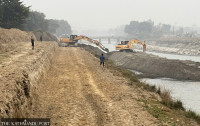National
Political instability, funds crunch cripple capital spending
Prime Minister Dahal is now heading 16 ministries after alliance partners UML, RSP and RPP quit the government.
Prithvi Man Shrestha
Prime Minister Pushpa Kamal Dahal didn’t have enough time to listen to the private sector representatives in a consultative meeting on the country’s economy on Sunday.
Dahal himself had organised the meeting at the finance ministry as he has also been looking after the finance portfolio following the resignation of Deputy Prime Minister and Finance Minister Bishnu Paudel last week.
“The prime minister kept us waiting for an hour and ended the meeting quickly, citing his scheduled meeting with President Bidya Devi Bhandari,” said a private sector representative who attended the meeting.
The private sector representative said the incident suggests there is a great work burden on the prime minister as he shoulders the responsibilities of multiple ministries.
Currently, Dahal heads as many as 16 ministries besides the PMO. This happened after the CPN-UML, the Rastriya Swatantra Party and the Rastriya Prajatantra Party pulled out of the government for different reasons.
“During the meeting, we asked the prime minister to give the Cabinet a full shape at the earliest, and prioritise the worsening economy,” said Vishnu Kumar Agrawal, president of the Confederation of Nepalese Industries (CNI).
Just two months after the new government was formed under Prime Minister Dahal in late December last year, he switched allegiance and joined hands with the Nepali Congress and seven parties, potentially inviting another prolonged bout of political instability.
A study report titled “Nepal Growth Diagnostic”, jointly prepared in 2014 by the government and the Millennium Challenge Corporation (MCC), a bilateral US foreign aid agency, had pointed out that policy instability was one critical constraint on Nepal’s economic growth. Policy instability caused by political instability, electricity shortage, high transport costs, poor labour relations and rigid labour laws were the binding constraints identified by the report.
While the country has improved in the areas of electricity availability and labour relations, political instability has again emerged as a key constraint. In the general elections last November, no party got a clear mandate to rule.
The biggest victims of the current political environment are the country’s development projects. “Political stability, administrative stability and policy consistency are a must to speed up development activities and attract investment,” said former chief secretary Bimal Koirala. “But the country has failed to ensure all three with frequent changes in the government and administrative leadership.”
Nepal’s construction sector in particular has badly suffered from unstable politics, according to officials and experts. Just when construction activities were beginning to speed up, the government started mobilising its employees for the November 20 federal and provincial elections last year.
After the elections, formation of the new government took over a month and just two months later, another government was formed after Dahal ended his alliance with the UML.
Frequent transfers of government employees have continued even during this fiscal year. The government’s failure to manage resources to fund development projects has also hit construction activities hard. The government has been indecisive while spending on development projects.
It has been around three months that the Ministry of Physical Infrastructure and Transport sent a request to the Finance Ministry to be allowed to transfer its own budget to another heading, for payment of completed works.
“We had requested the finance ministry to approve our proposal to transfer the funds allocated to our ministry to another spending heading where construction works have speeded up,” said Sushil Babu Dhakal, director general of Department of Roads, which comes under the physical infrastructure ministry. “The delay in giving approval is delaying work on such projects.”
“When governments change frequently, the bureaucracy cannot take decisions,” said former government secretary Tulasi Sitaula. “Bureaucrats who know that the government will change soon are also reluctant to follow the minister’s instructions.”
The private sector says that the construction industry as a whole has been badly affected due to the government’s failure to spend the development budget in addition to the slump in the real estate sector.
The demand for cement decreased by 40.2 percent and turnover of the engineering and construction sector suffered a decline of 43.7 percent in the first quarter of this fiscal year, according to a study report released by the CNI in December last year. The slump in construction has also dampened economic growth.
Nepal’s economy grew by just 0.8 percent, hitting a seven-year-low in the first quarter of this fiscal year, particularly due to the negative growth in five sectors: construction, mining and quarrying, wholesale and retail and repair of motor vehicles, transport and storage, and education, according to the National Statistics Office, previously known as the Central Bureau of Statistics. Mining and quarrying and the construction industry suffered the most, as they reported 29.2 percent and 24 percent negative growth, respectively.
“The government’s failure to spend capital budget contributed to a reduction in demand for construction materials,” said CNI President Agrawal. “There is a sharp decrease in demand for construction materials for housing purposes from individual households as well as the housing industry.”
Usually, government spending also contributes to an increase in private sector investments. “As private investment has slumped, it is vital that the government increases its own spending to help the economy,” said former chief secretary Koirala.
As of May 4 this fiscal year, the government’s capital spending stood at just 20 percent of the allocated budget, according to the Financial Comptroller General Office. The government has already reduced the spending size of the capital budget for the current fiscal year through a mid-term review of the budget, amid declining revenues.
“Currently, the contractors are struggling to receive mobilisation advance and the payment for completed works,” said Rabi Singh, president of the Contractors’ Association of Nepal. He also said the contractors have not been able to receive loans from the banking sector because of a liquidity crunch and high interest rates.
“The entire supply chain is now suffering from a lack of cash flow,” said Singh. “How can development projects speed up in such a dismal situation?”




 12.12°C Kathmandu
12.12°C Kathmandu















